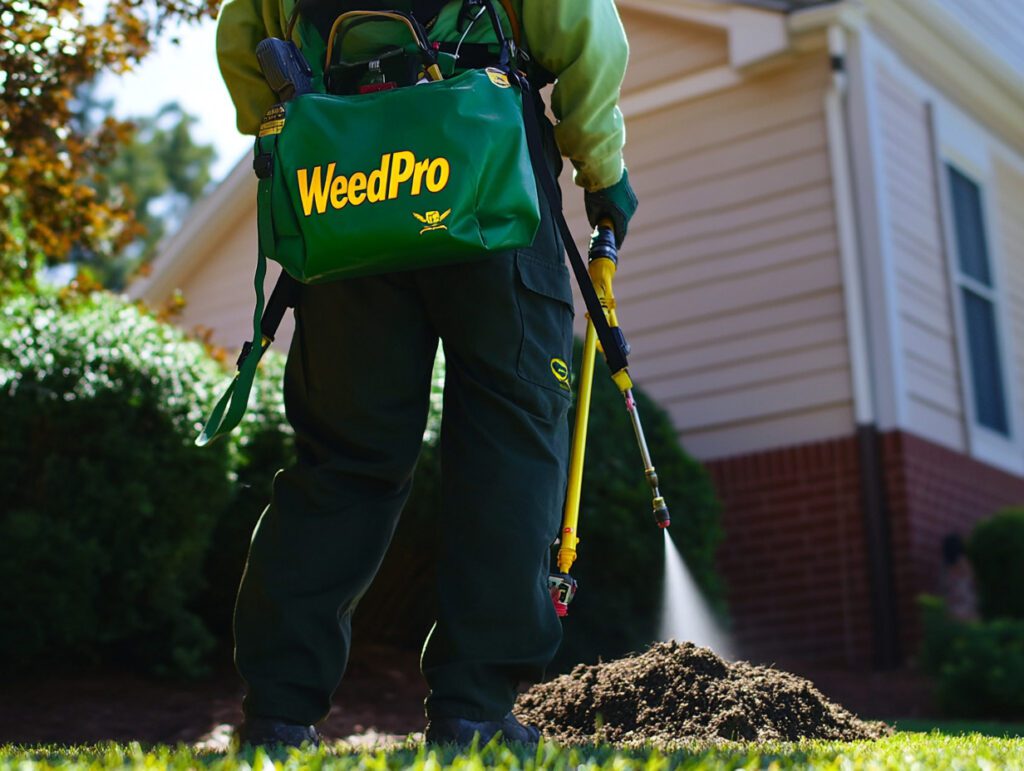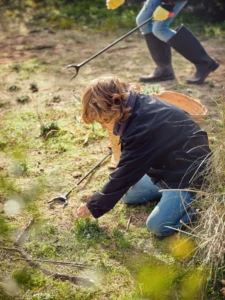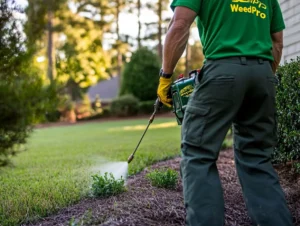Fire ants are a continuing concern for every yard and patch of green in and around Atlanta. Familiarity with what species you’ll be dealing with is an ace card in the hand for targeting the colonies, sustaining the grass, and saving yourself from their sting. This is a collection of five cardinal steps: identifying its main physical attributes, spotting its distinctive mounds, observing its belligerent conduct, distinguishing it from other neighborhood ants, and knowing when to call in professional help. Succeed in these and you’ll be on your way to creating a pest-free paradise in metro Atlanta and North Georgia.
What Are the Defining Features of Atlanta’s Fire Ants?
To identify fire ants, their color, body segments, and appendages play a crucial role. Having such knowledge allows the selection of optimal control methods for the health of your sod. This is the first step in distinguishing between uninvited nuisances and harmless species, ensuring you employ the proper treatment.
What Does a Red Imported Fire Ant Look Like in Georgia?
The red imported fire ant workers are no larger than 1/16 to 1/5 of an inch long, variable in form.
- Color: It is reddish-brown, while the gasters are quite dark brown to black (the thorax head part).
- Body segments: Has three distinguishable parts-head, thorax, and abdomen- and two remarkably visible nodes connecting thorax and abdomen.
- Antennae: Segmented: with an irregular number of segments, from 10 to usually 26
- Stinger: They possess a stinger at the end of their abdomen that they utilize to defend themselves.
Each of these characteristics enables you to distinguish them from all of the other lawn insects. Thus, any time you see something that resembles a fire ant, you will be aware of the dissimilarities quickly and take appropriate action.
How Do Southern and Tropical Fire Ants Differ from Red Imported Fire Ants?
Southern and tropical fire ants generally conform to the fire ant morphology described above; however, their primary differences lie in color and the type of nesting they prefer.
- Southern (Solenopsis xyloni): The southern fire ant has a yellowish-red head and thorax but a darker color on the abdomen. Nesting typically occurs under objects.
- Tropical (Solenopsis geminata): The tropical fire ant exhibits a similarly reddish coloration, and the workers are somewhat larger. Nesting typically occurs in dry sandy soils.
Recognizing minor differences will help determine whether you have a southern or tropical fire ant, which will dictate treatment plans.
What Are the Distinguishing Features of Other Common Atlanta Ant Species?
In addition to fire ants, several ant species are observed on Atlanta lawns that do not include fire ants. Most of those ants will not sting you and do not have noticeable mounds like fire ants may have.
- Argentine ants: These ants are small, dark brown ants (approximately 1/16 in). Argentine ants will forage in long trails across yards, unlike fire ants, which typically will build mounds. They do not build mounds.
- Carpenter ants: These are large (1/4 – 1/2 in) black or dark brown ants. Carpenter ants nest in wood, in contrast to nesting like fire ants, in loose soil.
- Odorous house ants: These ants are brown to black ants that, when crushed, have a “rotten coconut” odor. They can nest in both indoor and outdoor locations.
Knowing the difference between these harmless or less aggressive ants and fire ants keeps you from using unnecessary treatments and allows you to treat the actual fire ant threats.
What Are the Typical Shapes and Sizes of Fire Ant Mounds?
There is a variety of fire ant mound shapes, but they share some commonalities.
- Shape: They are typically smooth, either dome-shaped or conical in shape, and have no visible entrance hole.
- Height: They typically range in height from 6 inches to 18 inches.
- Width: They will sometimes spread out as large as 24 inches across the base.
When you see one of those distinctive domes in your open lawn, you will know it is your reference point for treatment.
Where Are Fire Ant Mounds Commonly Found in Atlanta Properties?

- Mounds will pop up out of the ground in warm, easy-dig soil.
- Sunny lawns and turfgrass areas
- Along the edges of sidewalks, driveways, and patios
- Near building foundations, water sources, or irrigation sites
- Knowing these common hot spots will allow you to make the fastest and most efficient inspection of the property for mounds.
How Do Fire Ant Mounds Differ from Other Ant Nests?
The most significant difference between a fire ant mound and other ant nests is that fire ant mounds do not have a central tunnel opening.
- Fire ants: Fire ants make smooth domes with the soil they excavate.
- Other ants: Ant nests often have noticeably visible entrance holes, soil grains on them, and mounds that appear flatter or more irregular in shape.
What Behavioral Indicators can you look for to Identify Fire Ants in Atlanta?
You can predict the presence of fire ants by their behaviors, such as aggressive swarming and distinctive stings.
What Happens When Their Mounds Are Disturbed by Human Activities?
Fire ants respond to disturbance with amazing speed, as they quickly swarm and “boil up” to the surface.
- Workers will emerge rapidly in seconds.
- When disturbed, they become agitated and sting vigorously.
- Nearby workers quickly get recruited to help defend the disturbed mound.
Understanding this aggressive behavior highlights the importance of protective gear and the need for professional control strategies.
What are Fire Ant Sting Symptoms and Related Health Risks?
A fire ant sting delivers venom into its victim, causing an immediate pain reaction and some risk of anaphylaxis.
- Pain: You will notice that you have been bitten and feel immediate, superficial, and pointed burning pain at the sting site.
- Red welts: Localized swelling with redness will also be evident.
- Pustules: Tender white bumps will typically rise within 24 hours, with pus-filled form beneath the surface.
- Health risks: Individuals with allergies may experience a severe allergic reaction.
Knowing these will hopefully help you with proper first aid and make informed decisions about when to seek medical care.
When to Seek Medical Care for Fire Ant Stings?
While many stings can be treated at home, you should visit the doctor for any of the following:
- Symptoms worsen beyond 48 hours and include expanding redness or fever.
- Signs of systemic allergy, such as difficulty breathing, hives, or dizziness.
- Pustules become increasingly painful, warm, and or have pus.
Getting checked out by an experienced medical professional in a timely manner may prevent further complications and protect the health and well-being of both humans and pets.
Can You Use a Comparison Table to Identify Fire Ant Species?
A handy comparison table can quickly highlight the key differences between local ant species, making identification a breeze.
| Species | Key Features | Typical Habitat |
| Red Imported Fire Ant | Reddish-brown, two petiole nodes, visible stinger | Sunny lawns, open turf |
| Southern Fire Ant | Yellow-red head, darker gaster, nests under objects | Garden beds, shaded edges |
| Tropical Fire Ant | Uniform red, larger workers, dryer soils | Sandy patches, landscape borders |
| Argentine Ant | Small, dark brown, no mounds | Foundation cracks, indoor areas |
This straightforward chart simplifies species recognition and helps you make informed decisions about control strategies.
What Should You Do If You Think You Have a Fire Ant Infestation In Atlanta?
As soon as you suspect fire ants are present, prompt and intelligent action must be taken on your part. This is necessary because you need to stop these pests from spreading and maintain control over your property. Most of the time, a stricter approach is necessary.
Why Is Professional Fire Ant Identification Important?
Identifying the actual species helps local homeowners avoid wasting time and potentially using ineffective do-it-yourself products.
- Professional Inspection: Experts are trained to locate active fire ant mounds and track down hidden or satellite nests.
- Species Treatments: Fire ants have specific biology and behaviors, so treatments should be tailored to the specific fire ant species.
- Safety: When recommendations are established, licensed technicians utilize protective measures to ensure your safety throughout the process.
Tapping into professional skills when managing fire ants significantly increases the chance that the species will be managed and that your lawn will recover.
Take Back Your Yard from Fire Ants Today

Fire ants are more than a nuisance—they’re aggressive, unsightly, and can harm kids, pets, and your lawn’s health. With Weed Pro, you’re not just getting another pest control company; you’re gaining a partner who understands Atlanta’s unique turf challenges. Our experts combine cutting-edge treatments with local knowledge to identify, treat, and prevent fire ant infestations before they spiral out of control. Don’t let these tiny invaders ruin your outdoor living spaces. We’ll tailor a plan that suits your property and lifestyle.
👉 Contact us today to schedule your fire ant inspection and reclaim your yard for good.
❓ FAQ
How can you tell if your yard has a severe fire ant problem?
Look for multiple large mounds, aggressive ants that become disturbed, and increased activity after rainfall. A professional inspection confirms the severity.
Can fire ants damage grass?
Yes, their tunnels disturb root systems, causing dry, uneven patches of turf. Severe infestations can ruin otherwise healthy lawns.
Are DIY methods enough to handle fire ants?
DIY methods can help small mounds, but widespread infestations usually require professional-grade treatments for long-lasting control.
🔗 Up Next:
Discover our next article: “Roswell’s Best Plants for a Stunning Landscape: Top Native, Drought-Tolerant, and Low-Maintenance Picks“







